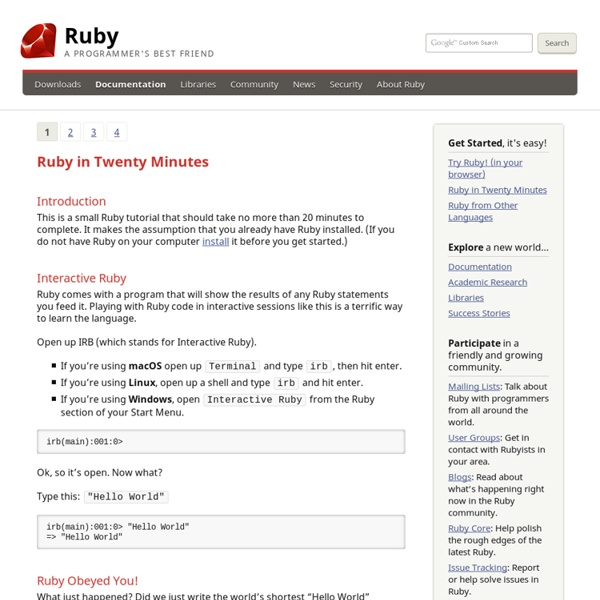



Ruby Tutorial Ruby is a scripting language designed by Yukihiro Matsumoto, also known as Matz. It runs on a variety of platforms, such as Windows, Mac OS, and the various versions of UNIX. This tutorial gives a complete understanding on Ruby. This reference has been prepared for the beginners to help them understand the basic to advanced concepts related to Ruby Scripting languages. Before you start doing practice with various types of examples given in this reference, I'm making an assumption that you are already aware about what is a computer program and what is a computer programming language. For most of the examples given in this tutorial, you will find Try it option, so just make use of it and enjoy your learning. Try following example using Try it option available at the top right corner of the below sample code box: #! 1 - Ruby Quick Reference Guide A quick Ruby reference guide for Ruby Programmers. Ruby Quick Reference Guide 2 - Ruby Built-In Useful Functions Ruby Built-In Useful Functions
Ruby Programming Tutorials Playlist Welcome to YouTube! Suggested Location Filter (we have set your preference to this): France The location filter shows you popular videos from the selected country or region on lists like Most Viewed and in search results.To change your location filter, please use the links in the footer at the bottom of the page. Click "OK" to accept this setting, or click "Cancel" to set your location filter to "Worldwide". The location filter shows you popular videos from the selected country or region on lists like Most Viewed and in search results. To change your country filter, please use the links in the footer at the bottom of the page. 1 4:17 Ruby Programming Tutorial - 1 - Installing Ruby by thenewboston 75,900 views 2 6:07 Ruby Programming Tutorial - 2 - Writing a Simple Program by thenewboston 15,378 views 3 4:16 Ruby Programming Tutorial - 3 - Math and Variables by thenewboston 7,238 views 4 4:58 Ruby Programming Tutorial - 4 - Classes by thenewboston 7,532 views About thenewboston
Learn Web Development with the Ruby on Rails Tutorial Learn Ruby with the Neo Ruby Koans Ruby tutorial Home This is a Ruby tutorial. In this tutorial you will learn the Ruby language. The tutorial is suitable for beginners. Table of contents Ruby Ruby is a dynamic, reflective, general-purpose object-oriented programming language. Related tutorials ZetCode has other programming language tutorials: Python tutorial, PHP tutorial, Tcl tutorial, Visual Basic tutorial, and C# tutorial.
Learn Ruby with the Neo Ruby Koans Ruby on Rails Ruby on Rails emphasizes the use of well-known software engineering patterns and principles, such as active record pattern, convention over configuration (CoC), don't repeat yourself (DRY), and model–view–controller (MVC). History[edit] On December 23, 2008, Merb, another web application framework, was launched, and Ruby on Rails announced it would work with the Merb project to bring "the best ideas of Merb" into Rails 3, ending the "unnecessary duplication" across both communities.[7] Merb was merged with Rails as part of the Rails 3.0 release.[8][9] Rails 3.2 was released on January 20, 2012 with a faster development mode and routing engine (also known as Journey engine), Automatic Query Explain and Tagged Logging.[11] Rails 3.2.x is the last version that supports Ruby 1.8.7.[12] Rails 3.2.12 supports Ruby 2.0[13] Technical overview[edit] Like many web frameworks, Ruby on Rails uses the model–view–controller (MVC) pattern to organize application programming. Framework structure[edit]
Solution stack In computing, a solution stack is a set of software subsystems or components needed to perform a task without further external dependencies. For example, to develop a web application, the designer needs to use an operating system, web server, database, and programming language. Another version of a solution stack is operating system, middleware, database, and applications.[1] Linux-based solution stacks[edit] Linux (the operating system) Apache (the web server) MySQL or MariaDB (the database management systems) Linux (operating system) Apache (web server) Seaside (web framework) Smalltalk (programming language) The cloud stack of LEAP for: AppScale (Cloud computing-framework and free and open-source alternative to Google App Engine), OpenStack Linux – OpenStack controller nodes run exclusively on Linux OpenStack – providing an infrastructure as a service (IaaS) Ganeti Xen or KVM (hypervisor) Distributed Replicated Block Device (storage replication) Ganeti (virtual machine cluster management tool) Node.js
rails/rails